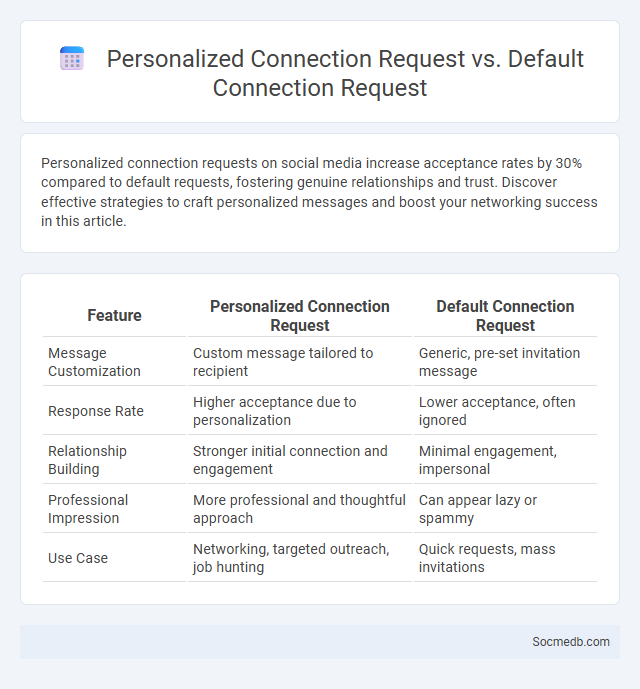
Photo illustration: Personalized Connection Request vs Default Connection Request
Personalized connection requests on social media increase acceptance rates by 30% compared to default requests, fostering genuine relationships and trust. Discover effective strategies to craft personalized messages and boost your networking success in this article.
Table of Comparison
| Feature | Personalized Connection Request | Default Connection Request |
|---|---|---|
| Message Customization | Custom message tailored to recipient | Generic, pre-set invitation message |
| Response Rate | Higher acceptance due to personalization | Lower acceptance, often ignored |
| Relationship Building | Stronger initial connection and engagement | Minimal engagement, impersonal |
| Professional Impression | More professional and thoughtful approach | Can appear lazy or spammy |
| Use Case | Networking, targeted outreach, job hunting | Quick requests, mass invitations |
Understanding Connection Requests: An Overview
Connection requests on social media serve as a fundamental tool for expanding networks and fostering professional relationships. These requests enable users to initiate contact, share information, and collaborate within platforms like LinkedIn, Facebook, and Twitter. Understanding the dynamics of acceptance rates, personalized messages, and mutual interests significantly enhances the effectiveness of connection-building strategies.
What is a Default Connection Request?
A Default Connection Request on social media platforms like LinkedIn is the standard invitation sent to connect with another user without any personalized message. It enables users to quickly expand their network by sending a generic request that the recipient can accept or ignore. This default option streamlines the connection process but may result in lower acceptance rates compared to personalized messages.
The Rise of Personalized Connection Requests
The rise of personalized connection requests on social media platforms significantly enhances user engagement by fostering authentic interactions and meaningful networking opportunities. Tailored messages leveraging user interests, mutual connections, and professional backgrounds increase acceptance rates and build trust within digital communities. Social media algorithms prioritize these customized outreach efforts, amplifying visibility and long-term relationship growth.
Key Differences: Default vs Personalized Requests
Default social media requests trace standard user behaviors based on pre-set algorithms and generic demographic data, offering a one-size-fits-all experience. Personalized requests utilize machine learning and user-specific data such as past interactions, preferences, and real-time context to tailor content previews, advertisements, and recommendations uniquely for each profile. This distinction enhances user engagement by aligning platform output with individual interests and behavioral patterns, driving higher conversion rates and session durations.
The Psychology Behind Connection Requests
Connection requests on social media tap into the human need for belonging and validation by triggering dopamine release when accepted, reinforcing positive social behavior. Your brain interprets these requests as social affirmations, boosting self-esteem and fostering emotional bonds through perceived mutual interest. Understanding this psychological mechanism can enhance how you manage online relationships and build meaningful digital communities.
Impact on Response Rates: Personalized vs Default
Personalized social media messages significantly increase response rates by addressing users' specific interests and behaviors, creating a sense of relevance and engagement. Default, generic messages often result in lower interaction as they fail to capture the attention or needs of individual users. Studies show personalized content can boost response rates by up to 50% compared to standard, one-size-fits-all approaches.
Crafting an Effective Personalized Connection Request
Crafting an effective personalized connection request on social media increases the likelihood of building genuine relationships by referencing shared interests, mutual connections, or recent activities. Your message should be concise, authentic, and tailored to the recipient's profile, demonstrating sincere intent and respect for their time. This approach enhances engagement rates and fosters meaningful networking opportunities across platforms like LinkedIn, Instagram, and Twitter.
Common Mistakes with Default Connection Requests
Sending default connection requests on social media often leads to low acceptance rates and missed networking opportunities because they appear impersonal and generic. Personalizing your invitation by referencing shared interests or mutual connections significantly increases the likelihood that Your request will be accepted and valued. Avoiding this common mistake can greatly enhance relationship-building and professional visibility on platforms like LinkedIn.
Strategic Use of Connection Requests for Networking
Strategic use of connection requests on social media enhances your professional network by targeting relevant industry leaders and potential collaborators. Personalizing each request with clear, value-driven messages increases acceptance rates and paves the way for meaningful interactions. Consistent engagement with new connections strengthens relationships and maximizes networking opportunities.
Best Practices for Connection Request Success
Personalize your connection requests by referencing common interests or mutual connections to increase acceptance rates. Keep your message concise and clear, stating your purpose and how the connection can be mutually beneficial. Avoid generic templates and ensure your profile is complete and professional to build trust with Your potential network.
 socmedb.com
socmedb.com